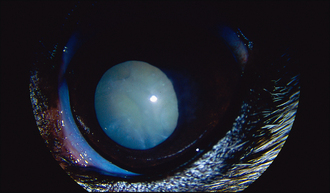40 Diabetic cataract in a dog
CLINICAL EXAMINATION
Ophthalmic examination will reveal reduced or absent menace responses and poor vision. Pupillary light reflexes are often normal, but occasionally are slightly sluggish. Some conjunctival hyperaemia or episcleral congestion can be present. The iris might be uniformly dark. However, the most striking abnormality is the presence of bilaterally symmetrical total mature cataracts. Frequently the lenses appear slightly ‘swollen’ (intumescent) and water clefts along the suture lines are apparent (Figure 40.1). Fundus examination is rarely possible. If intraocular pressure can be measured it is frequently slightly below normal (e.g. 8–12 mmHg). Lens-induced uveitis is very common in sudden onset cataracts, particularly those induced by diabetes mellitus. Schirmer tear test readings should be recorded and the cornea stained with fluorescein to check for ulceration.




